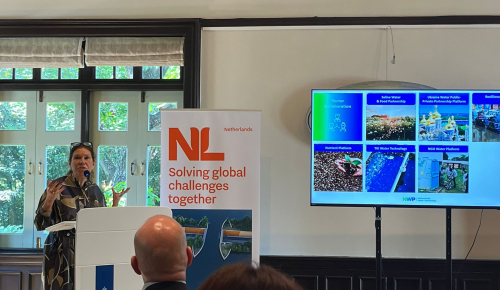Blog
14 November 2019Groundwater level data are key for integrated solutions

Adequate groundwater levels are becoming rare worldwide. Large-scale extraction is causing subsidence and salinisation, and has major consequences. No wonder it was busy at water level data specialist and NWP member Van Essen Instruments’ stand at Aquatech at the Amsterdam International Water Week last week. Peter Westerhuis, International Distribution Manager, is feeling the growing urgency of the groundwater situation.
‘We produce and sell measuring equipment to monitor groundwater levels. This is mainly done to identify long term trends. Hydrologists and policymakers need our data to come up with solutions and to develop policies.
The best-known examples of the consequences of uncontrolled groundwater extraction are cities that are slowly sinking. Actually, there are also cities such as Jakarta that are sinking quite fast. Falling groundwater levels can cause problems with drinking water supply, the quality of buildings (for example the rotting of wooden piles that support houses in the Netherlands) and agriculture. In agriculture, falling groundwater can cause salinity which, along with drought, can have major consequences on production.
Increasingly urgent
Measuring the groundwater level is generally a public issue worldwide, and in particular for municipalities, provinces, water authorities, and drinking water companies. Anyone extracting groundwater must generally comply with legislation and put relevant measures in place. Unfortunately, it is not always easy to enforce these rules everywhere. One example is the mining industry which uses a lot of water for processing. In recent years, more and more attention has been paid to measuring groundwater levels, as the problems are becoming increasingly urgent. If groundwater is continuously extracted in areas where it cannot be refilled through infiltration of rainfall, for instance, problems are inevitable. And data is essential to both map the severity of these problems and point to the best direction for sustainable solutions.
Finding integrated solutions
There is much to be done and this is why we are involved worldwide. This week I took part in Partners for Water’s Myanmar Country Platform. With other sector members, we are looking into integrated approaches in Myanmar and preparing for forthcoming tenders. Myanmar would benefit from a monitoring network to get a good picture of the groundwater situation. This would be a good foundation on which to develop a sustainable policy.
Dutch Pavilion brought 40 to 50 leads to work on
We definitely noticed a sense of urgency at Aquatech, where we had a spot in the Dutch Pavilion, which, as an aside, looked incredible nice. Being part of the Dutch Pavilion was an easy decision. The Pavilion attracted delegations of policymakers and decision-makers from all over the world who were there to attend the AIWW Conference. The Dutch Pavilion was a beehive of activities with all kinds of presentations, tours and meetings at the end of each day. And our expectations were met – we have 40 to 50 leads to work on. This is definitely the most economical and the fastest way to achieve these results.
Contribution to global issues
At Aquatech we met a company that measures groundwater in Africa and is interested in our products. This is very general and it can take a long time to develop. But there was also a delegation from South Africa which is lagging behind in mandatory measurements, so this may go a lot faster. Coincidentally, we will be in South Africa ourselves next week, so we can take that lead a step further and continue to make our modest contribution to finding well-founded solutions for global groundwater issues.’
Five golden rules
If you are part of a pavilion, you need to do it right. I would like to share my five golden rules for participating.
- The time has passed where visitors come to exhibitions to fill a bag with glossy brochures and free pens. If this is why you do it, don’t go. Exhibitions now require much more focus and preparation.
- Determine very carefully in advance: what do I have to offer, what has added value for the visitors, and what will increase my business at the same time.
- People are visually oriented, so make sure they immediately see something that appeals to them and is clear. This is important to attract that first wave of interested visitors. For us, our visual was our clear motto ‘groundwater is our business’.
- Be strict when talking to visitors. If you are talking to someone you meet five times a year in the Netherlands and you notice there is someone else waiting, someone who you don’t know and may leave if it takes too long, wrap up the conversation and approach the new person.
- Making quotes at a trade show is also a thing of the past. Most of the work comes afterwards. A deal may sometimes be closed quickly, but sometimes the lead time is a full year. So make sure to find a good balance: not everything fast, not everything long-term.
Featured NWP members: Van Essen Instruments






